An Oracle BI "Blast from the Past": Ten Products from Oracle's BI History You May Not Have Heard Of...
With Oracle BI Enterprise Edition, the BI Apps and Hyperion EPM Suite, Oracle have a set of reporting and analysis tools that can be considered "best of breed" and compete with any other tool on the market. Coupled with the Oracle database, the engineered systems strategy and the Fusion Apps/Apps Unlimited ERP suites, as a BI developer it's pretty clear we "bet on the right horse" in terms of which company we backed as developers. But it's not always been as plain sailing as this, and like every other software company Oracle have released a few products over the years that didn't take-off so well, never really came together or just got eclipsed by other acquisitions Oracle made over time. So lets take a light-hearted count-down through the Oracle BI, DW and ETL products released over the years that you may not have heard of, but at least some of us bear the scars from trying to implement ….
10. Oracle Warehouse Builder 10gR2's Data Quality and Enterprise ETL Options
Back in the days before Oracle Data Integrator, Oracle Warehouse Builder was Oracle's strategic data integration tool, initially sold on a per-developer basis but in time, bundled in with the Oracle database to match similar product packaging from Microsoft.
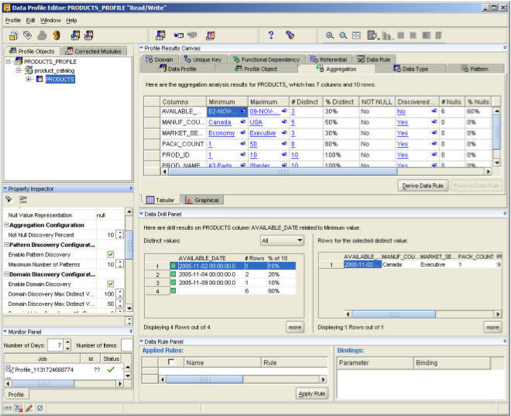
LIke the old saying about technology reaching the point of perfection before then becoming obsolete, in retrospect OWB10gR2 pretty much got it right in terms of Oracle-centric data integration, and the Data Quality option in particular has yet (to my mind) to be surpassed in term of data quality integration with an Oracle ETL tool. Of course, with the acquisition of Sunopsis Oracle went with ODI as their strategic ETL tool, driven mostly by the fact that it was cross-platform and had a bit more of a SOA/middleware angle than did OWB, but it's still a shame to see OWB being de-emphasised over the years and we still miss its dimensional data modelling capabilities, integration with Oracle OLAP, and of course the data quality features that were introduced with OWB10gR2's Data Quality Option.
9. Oracle Browser, Oracle Data Query, and Oracle Discoverer
Again, products made obsolete by newer and better ones coming through, rather than failing in themselves, Oracle Browser was Oracle's first proper ad-hoc query tool, which in turn begat Oracle Data Query, which then begat Oracle Discoverer, still in use across many EBS sites and still with some features yet to be incorporated into Oracle BI Enterprise Edition.
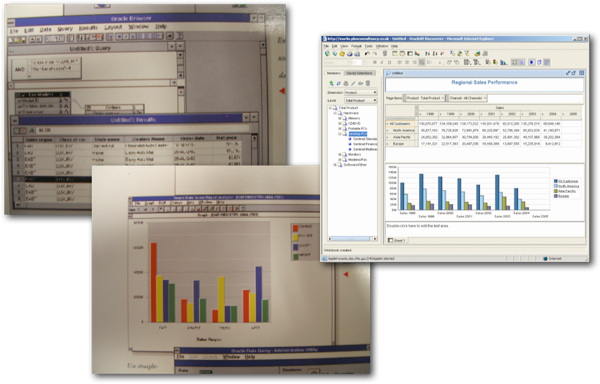
But its easy to get rose-tinted-spectacles about Discoverer; having to dig out and maintain ancient Oracle JInitiator Java browser plug-ins to get Discoverer Plus to work; Discoverer Viewer only having a fraction of the functionality of Discoverer Plus; the web-based version of Discoverer first appearing with Oracle 9iAS, possibly the worst piece of Oracle software ever released, and so on. But for getting the job done with minimal fuss, Discoverer is still hard-to-beat as an ad-hoc query tool for the Oracle database, and of course its' still available and runs now as part of the Fusion Middleware 11g setup, and it'll still be maintained and developer for as long as there's EBS customers out there wanting to do some simple exploration of their ERP data.
8. Oracle Data Mart Suite
Here's one for an Oracle BI Trivial Pursuit quiz - what was the name of Oracle's first combined ETL, data warehousing and reporting product suite, based around Oracle 8i and using ETL code licensed from Sagent? The answer is Oracle Data Mart Suite, a largely-forgotten precursor to Oracle Warehouse Builder that combined Oracle Discoverer, Oracle Designer and a tool called Oracle Data Mart Builder along with Oracle 8i to create Oracle's first end-to-end BI & data warehousing tool.
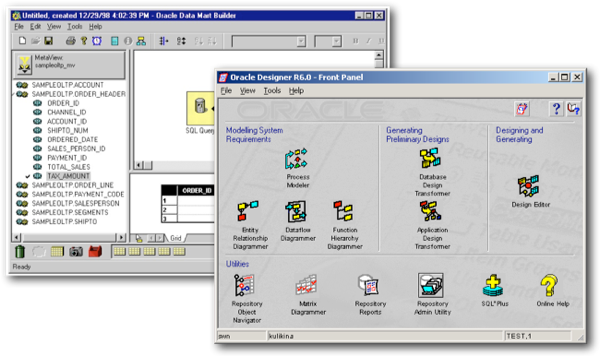
Some of the concepts are very familiar to us now - a central repository, agents to collect metadata and run code, graphical tools to create data models and define ETL processes - but Data Mart Builder was Windows-only when Oracle were just about to move wholesale into Linux with Oracle 9i, and of course the ETL functionality pre-dates the inbuilt SQL ETL that came with Oracle 9i. Oracle Warehouse Builder 2.1 came along towards the start of the 2000s and replaced Data Mart Builder and Data Mart Designer, but Discoverer lived on and Oracle still really haven't got a single install, single metadata store solution to replace it. Data Mart Suite even pre-dates my involvement with Oracle, but I'd be interested if anyone reading this (my guess - Kent Graziano ;-)) has any first-hand experience in working with it.
7. Oracle Darwin
Just around the same time as Oracle 9i was released, Oracle made the acquisition of Thinking Machines, a data-mining and supercomputer company based out in the States who sold a product called Darwin, a Clementine-like GUI analytical workbench that Oracle later rebranded as "Oracle Data Mining".
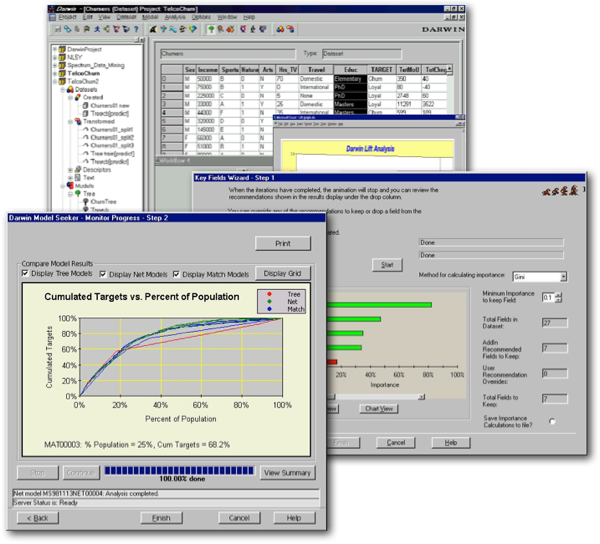
Darwin never really saw the light of day with Oracle but the internal algorithms and technologies went on to form the core of the Data Mining Option for the Oracle Database (now part of the wider database Advanced Analytics Option), which now has GUI elements of its own but does all of the processing in the Oracle database. Technology derived from Darwin can also be found today in products like Oracle Spend Classification, working under the covers to classify corporate spend using data mining classification algorithms.
6. Oracle BI Applications 7.9.5.2
Now we're getting into the interesting ones. Four weeks of my life I'll never get back were spent back in 2009 getting to grips with the first version of the Oracle BI Apps that used ODI, rather than Informatica, as the ETL tool. Sources and targets in this initial release were limited to just EBS 11.5.10 on Oracle Database 10gR2, but other than that it was fully-functional, with a method for doing customisations, new configuration tools that did away with the need for the DAC, and all of the relevant SDE and SIL mappings re-implemented as ODI interfaces and packages.
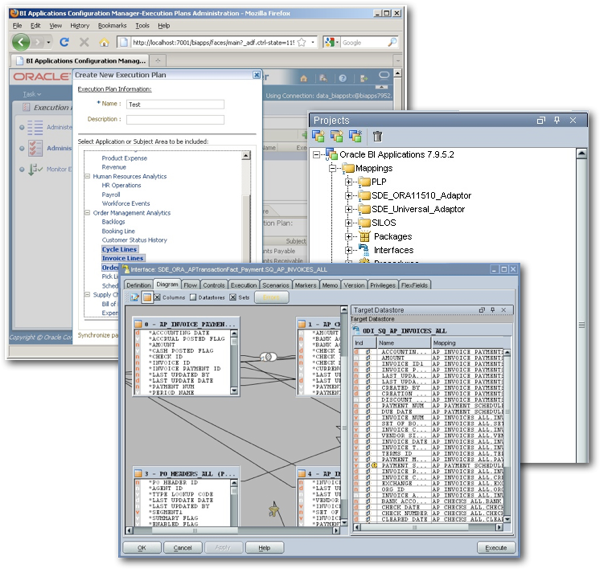
But this was back in the days of ODI10g, and there were no load plans or any other features since introduced to ease the move to ODI with the BI Apps, and the customisation approach was slightly scary and complex, to say the least. In the end, only one release of BI Apps on ODI10g ever came out, but of course we're now just nearing the point where BI Apps 11g gets full support for ODI as an alternative to Informatica as the ETL tool, and seeing the various workarounds Oracle had to do with ODI to get it to work as an Informatica alternative back in 2009 made it obvious to me why features such as load plans were introduced over the past few years.
5. The Oracle BI Spreadsheet Add-in for Excel
A spreadsheet add-in with less useful functionality than Oracle BI Office, the GUI performance of Warehouse Builder and an OLAP server back-end that nobody used. One of a number of entries in this chart based around Oracle 9i OLAP.
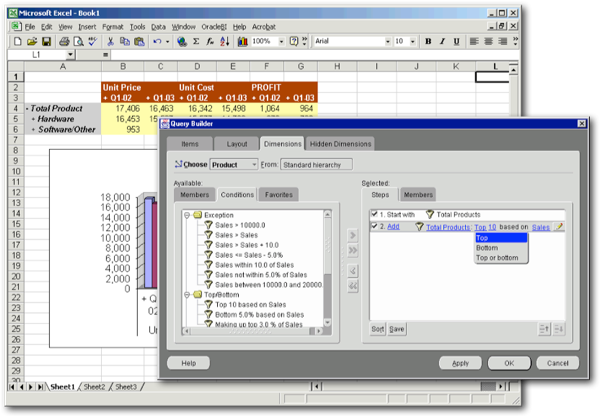
This, and No.1 on our list were probably the single biggest reason Oracle ended-up buying Hyperion - the chances of an accountant actually using this Excel add-in, as opposed to say Hyperion's Essbase add-in, were about as close to zero as you could get, assuming you could find anyone still using Oracle OLAP after the bodged migration from Express Server. But - Oracle 9i OLAP going so badly paved the way, in time and several years later, for the Hyperion acquisition, and now Oracle OLAP sensibly focuses on the Simba MDX Provider for Oracle OLAP along with Microsoft Excel pivot tables, the descendants from this product release are actually pretty darn good.
4. Oracle Business Intelligence Essbase Integrator
Another one for Oracle BI Trivial Pursuit - which product from Oracle integrates OBIEE, Essbase and the BI Apps, so that you can click on links on your BI Apps dashboard and launch Smarview, preserving the POV context from the related analysis on the dashboard?

The answer is the Oracle Business Intelligence Essbase Integrator, a product launched by Oracle back in 2010 and which appeared to me, at the time, as wildly ambitious but solved a real problem - how do you combine the capabilities of Essbase and OBIEE whilst in the background, keeping their metadata in-sync.
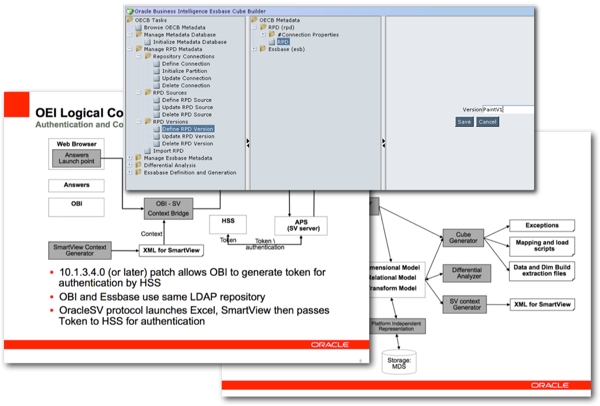
Rather predictably, we didn't really hear much about this product again which was a shame, as the concept was superb (albeit a bit "Heath Robinson", or "Rube Goldberg" as the Americans would say). I suspect we'll see something around this same concept going into the 12c timeline as it's such an obvious "win" for Oracle, but for now, it's a product best known as the challenge we set Stewart Bryson back at the Brighton BI Forum 2011 when Venkat couldn't make it over - present Venkat's OBI Essbase Integrator session as if it were his, and without seeing the content of each slide until it came up on the projector.
3. Oracle Daily Business Intelligence
Prior to the BI Apps and around the time of Oracle E-Business Suite 11i, reporting against EBS data was done either through Discoverer, or through Oracle Reports and FSGs. Oracle Discoverer could integrate with Oracle Portal, but it was fairly primitive integration and Portal wasn't really cut-out to be a BI Portal, more being used for intranet-style applications like data entry and staff directories.
Oracle Daily Business Intelligence (DBI) improved on this situation in two ways; first, it was based off-off Oracle Database materialised views, speeding up report response times and, in theory, taking the load off of your underlying ERP system; second, it had its own custom portal and dashboard framework that was faster, more responsive and "tighter" than Oracle Portal and its Discoverer portlets.
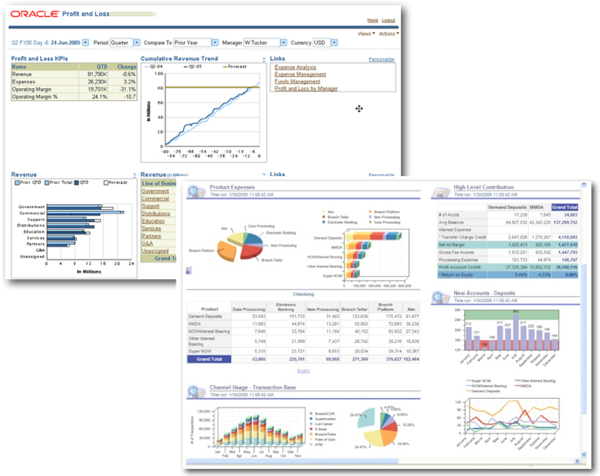
DBI may well have got more traction over time but probably was eclipsed by the major acquisition spree that Oracle went on in the early 2000's, buying Peoplesoft (and thereby JD Edwards) and Siebel, and then using Siebel Analytics along with BEA's WebLogic tooling to create the successor BI-on-ERP platform, OBIEE and the BI Apps. Which was probably a good thing in the end, as I never met anybody actually able to customise Daily Business Intelligence, a task that makes customising the BI Apps seem like plugging your iPod into iTunes running on a Mac.
2. Oracle 9i OLAP, and Oracle Business Intelligence Beans
On to the final two, and they're both based around Oracle 9i OLAP, Oracle's (in retrospect) disasterous replacement for Oracle Express Server which lost them the OLAP market they owned back in the late 90's. I've got mixed feelings on 9i OLAP as I know many of the people involved in its development and marketing, and nowadays in its database OLAP option form it's an excellent product, I think technically and architecturally better than Essbase. But the introduction of Oracle 9i OLAP was a masterclass in suicidal product marketing; first, there was no backward compatibility with Express Server tools, so all of the users of Oracle Financial Analyzer and Oracle Sales Analyzer had to wait years for the product at #1 in our list, with of course most of them decamping to Microsoft OLAP Services or Arbor Essbase instead. The first version of Oracle 9i OLAP was ROLAP only, with terrible, buggy performance and a wait of a year or so before the MOLAP version came out, again without backwards compatibility with Express Server tools (due to the removal of the key SNAPI and XCA communications APIs that Express Server applications used)
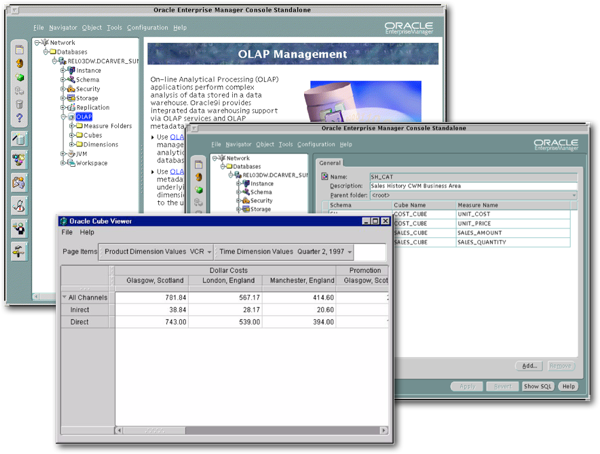
All of this made great technical sense, and if the MOLAP version of 9i OLAP had come out at the same time as the ROLAP version, and if Oracle somehow managed to keep SNAPI support so that OFA and OSA customers could technically migrate their OLAP cube to Oracle 9i without loosing their tool access. It may have all worked out. But the "icing on the cake" was the lack of any proper ad-hoc or OLAP query tool support right at the start (Discoverer "Drake" came a few years later), with customers expected to - get this -write their own BI tool using a Java component technology called Oracle Business Intelligence Beans.
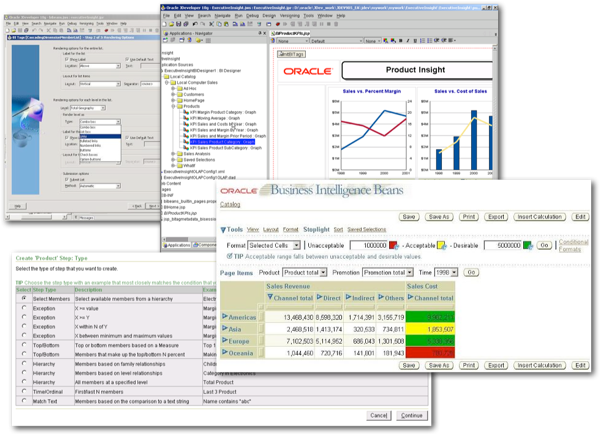
A few parters, including myself in this bit of history from around ten years ago, gamely tried to generate interest around 9i OLAP and BI Beans, but combined with Microsoft's entry into the OLAP market and Arbor (and then Hyperion's) focus on the finance department, rather than DBAs and IT who never actually buy OLAP servers, Oracle OLAP never regained the market share that Express Server had, even though as I said earlier it's arguably a better, more scalable and easier-to-manage OLAP Server than Essbase.
The last laugh is on the BI Beans product development team though, as the BI Beans query builder became the inspiration for OBIEE 11g's "Selection Steps" feature, whilst its data visualisation components found their spiritual successor in ADF's Data Visualization Tools (DVT) feature, which provides the BI visuals behind OBIEE, the latest version of Endeca Information Discovery, and of course the Oracle Fusion Apps.
1. Oracle Enterprise Planning & Budgeting
Number one in our list of Oracle's slightly crazy BI tools from the past was Enterprise Planning & Budgeting, the long-awaited replacement for Oracle Financial Analyzer and Oracle Sales Analyzer based around the Oracle 9i OLAP platform. More akin to the Stone Roses' "Second Coming" and about as well critically received, EPB was the "aircraft carrier" to OFA's "motor torpedo boat", had a list as long as your arm of critical patches you had to apply before you could use it, and required installation along with EBS (and knowledge of a set of arcane setup steps) before you could use it.
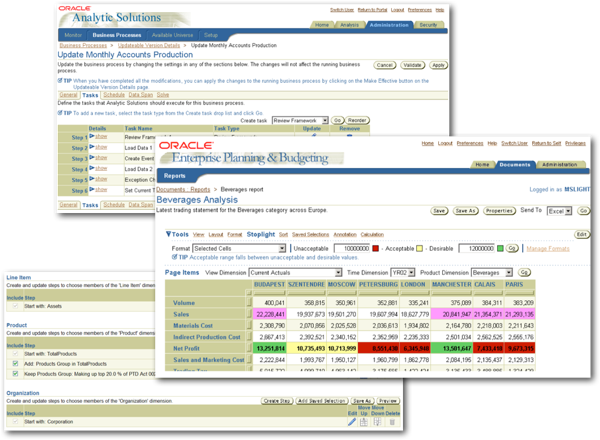
Coupled with a painfully-slow user interface for users typically used to split-second OFA response-times, EPB was long in the coming but quickly despatched when Oracle first adopted Siebel Analytics and the BI Apps as their new BI Platform, and then bought Hyperion and made Essbase and Hyperion Planning the centrepiece of their performance management strategy, something that carries on to this day.
So there we have it - a light-hearted look through some of the Oracle BI products that didn't make it to the big time, and a bit of history to explain why OBIEE and EPM Suite are the tools we use today. Most of the Oracle PMs who looked after these tools are still with us, working on OBIEE and its related technologies, so apologies if I've inadvertently offended anyone by picking on one of the products they looked after - it was all fun at the time and most of the products would have stayed with us, and gone on to be successes were it not for the massive strategic shift Oracle made back at the turn of the century towards cross-platform, and away from the Oracle database begin the centre of everything. Let me know if you've had any experiences with these tools, or if you've got any corrections or additions to their stories.